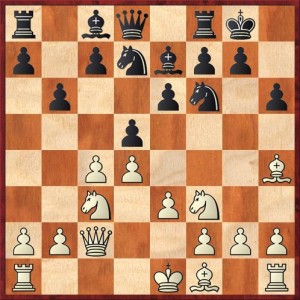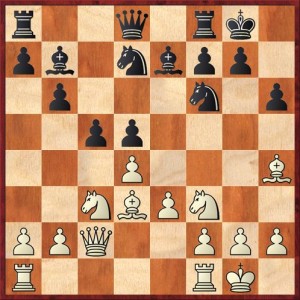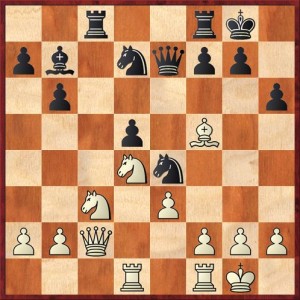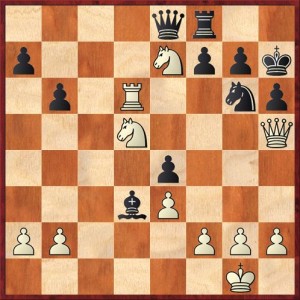At Mike Splane’s most recent chess party, Craig Mar showed us a really nice game he played years ago. Even though he doesn’t play tournament chess any more, he is a really good teacher and the games he shows us are usually as relevant as they were when he played them.
This time he told us he was going to show us “How a Master Eats an Expert.” All of the moves that Black plays in this game are superficially reasonable, and yet he ends up in huge trouble and loses a miniature. How did this happen? Well, let’s see.
Craig Mar – NN, Queen’s Gambit Declined
1. Nf3 Nf6 2. c4 e6 3. Nc3 d5 4. d4 Be7
There are many options here for Black. I always used to play 4. … c5, called the Semi-Tarrasch, taking advantage of the move order, which allows Black to not get an isolated queen pawn.
5. Bg5 h6 6. Bh4 Nbd7 7. e3 O-O 8. Qc2 b6?!
 Position after 8. … b6. White to move.
Position after 8. … b6. White to move.
FEN: r1bq1rk1/p1pnbpp1/1p2pn1p/3p4/2PP3B/2N1PN2/PPQ2PPP/R3KB1R w KQ – 0 9
Although you can find grandmaster games where Black has played this move, I think that it is slightly misguided. Both sides are playing a waiting game, trying to get more information. Craig avoided 8. Bd3 because it gives Black information and allows him to play 8. … dc, winning a tempo. Similarly, Black could play a noncommittal move like 8. … c6 and throw the ball back into White’s court. Or he could play 8. … c5, which again puts the onus on White to figure out how he is going to open the center. With 8. … b6, Black announces that he is developing his bishop on b7. That allows White to take on d5, a move that now has strategic value because it will lock in the bishop on b7. In this sort of position, the bishop on b7 has nothing to do.
Not surprisingly, in ChessBase White wins 58 percent of the games after 7. … O-O but 66 percent after 8. … b6.
9. cd ed 10. Bd3 c5 11. O-O Bb7
 Position after 11. … Bb7. White to move.
Position after 11. … Bb7. White to move.
FEN: r2q1rk1/pb1nbpp1/1p3n1p/2pp4/3P3B/2NBPN2/PPQ2PPP/R4RK1 w – – 0 12
Talking about this position at the chess party, Craig said that Black’s position feels loose. There’s a lot of space behind those d5 and c5 pawns, which might turn into “hanging pawns.” There is also some incipient weakness on Black’s kingside, due to the weakening move … h6. This is a type of formation that is especially vulnerable to a knight coming to f5.
12. Rad1 Rc8?!
Wow, Black’s winning percentage on ChessBase just plummeted from 33 percent to 17 percent! How can such a natural move be bad? Well, the trouble is that White has a bishop that can get on the h3-c8 diagonal. Black’s rook doesn’t really have a comfortable square on the c-file. All of this goes back to the unfortunate decision to fianchetto the queen bishop too early.
13. Bf5 cd 14. Nxd4 Ne4 15. Bxe7 Qxe7
 Position after 15. … Qe7. White to move.
Position after 15. … Qe7. White to move.
FEN: 2r2rk1/pb1nqpp1/1p5p/3p1B2/3Nn3/2N1P3/PPQ2PPP/3R1RK1 w – – 0 16
Now Craig plays a move I really like. To motivate it, he asked us, “What piece would you really like to have on f5?” And of course there is also a huge hole on d6. Remember Craig’s comments about all the empty space in Black’s position. Now that is coming into play.
16. Bxe4! …
A lot of people don’t like to give up a bishop for a knight. But take a look at the pieces that are left! White’s two knights turn into monsters.
16. … de 17. Nf5 Qe6 18. Nd6 Ba6
In the only game in ChessBase to reach this position, Vakhidov-Kalogiannis 2000, Black waved the white flag and sacrificed the exchange with 18. … Rxc3. It didn’t work any better.
19. Nxc8 Bxf1 20. Rd6! …
This move speaks to the form and confidence of a master. White could win a pawn with 20. Qxe4 and would most likely grind down Black in the endgame. But Craig smells blood in the water and doesn’t settle for just winning a pawn.
20. … Bd3 21. Qd1! …
Another kind of move I like: retreating to attack! The queen is heading over to the kingside, where it will exploit those weak squares I talked about earlier. It’s just wonderful to see how all the ingredients work together in this game.
21. … Qe8 22. Nd5 Kh7 23. N8e7 Ne5 24. Qh5 Ng6
If 24. … f6 it looks as if 25. Qf5+ followed by Re6 is decisive.
 Position after 24. … Ng6. White to move.
Position after 24. … Ng6. White to move.
FEN: 4qr2/p3Nppk/1p1R2np/3N3Q/4p3/3bP3/PP3PPP/6K1 w – – 0 25
It seems as if Black has gotten himself out of trouble, because the rook sacrifice Rxh6+ is no longer possible. At the same time, he is finally threatening to trade off one of White’s rampaging knights. How can White break through?
(Space inserted if you want to think about it.)
25. Nf6+! Black resigns
Everyone can see that White would like to play Nf6+ to fork the king and queen. Everyone can see the Black’s g-pawn defends that threat. What not everyone can see is that White can do it anyway! One of the secrets of mastery is that when your opponent “prevents” a move, you find a way to play it anyway. Here the point is that after 25. … gf 26. Nf5, Black simply can’t get him out of the threat of Qxh6 followed by Qg7 mate.
A really stylish performance by Craig!
Note: Typo on move 17 corrected 4/8/2014.



{ 2 comments… read them below or add one }
I think you mean 17. Nf5 (rather than Nf6). Great post; thanks!
Correct. I’ll fix the typo.